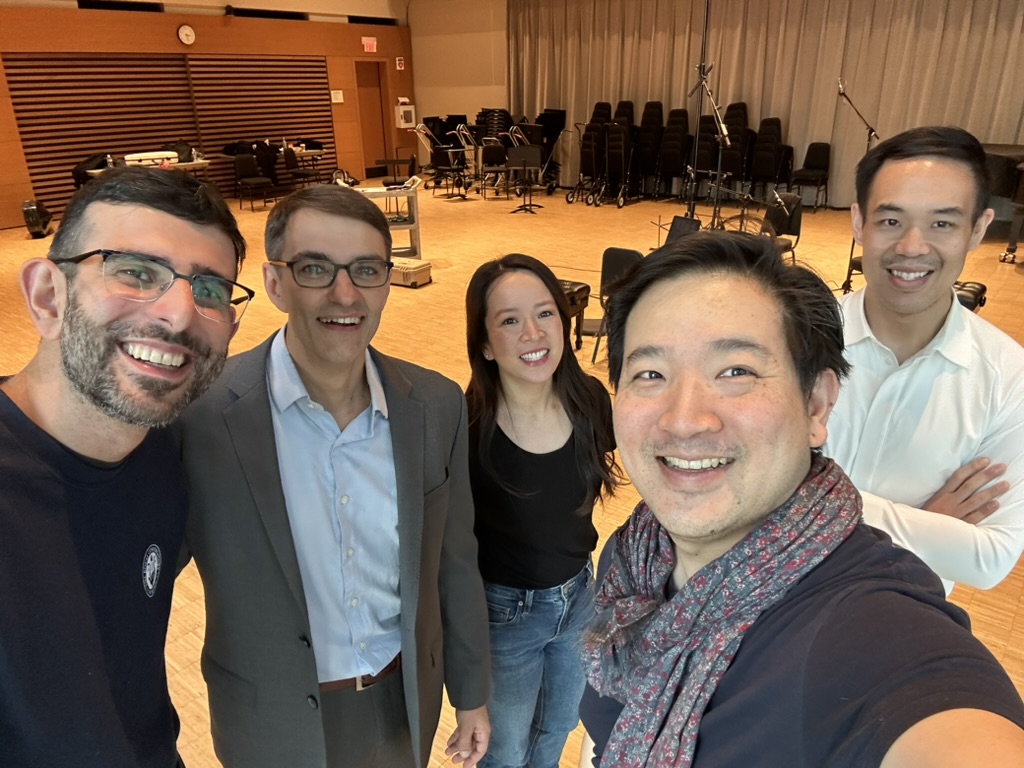Left to Right: Pouya Hamidi (recording engineer extraordinaire), Timothy Kantor, Valerie Li, Adrian Fung, Eric Wong
We just finished four long days of recording — my quartet and I, huddled around microphones, headphones on, parsing every gesture into eternity. There’s a particular pressure knowing that whatever you play is, in some way, “forever”. There’s something unnatural and natural about it.
This new project is a sequel of sorts to Spin Cycle, a collaborative whirlwind of old and new music. But this time, with just the four of us in the room, the experience felt quieter, deeper — a kind of meditation on what it means to make music together when the stakes are high and the red light is on.
It’s during these sessions that you discover a certain truth: Your personal best take might never see the light of day. Not because you missed a note. It’s the opposite. Maybe you nailed the phrasing, the energy, the tone. But if someone else had a flub, or if the balance felt off, or if a chair creaked during the final pianissimo, it’s gone.
The group must move on and the take ends up on the cutting room floor.
This is not a complaint — it’s a quiet celebration of ensemble life. In a string quartet, perfection is collective. Your brilliance only matters if it lives well beside someone else’s.
Sometimes, you wonder whether the constant pursuit – that “perfect” take – is worth it.
The Cost of Chasing Perfection
Recording is a paradox: We try to bottle spontaneity in a medium designed for permanence. That tension creates a subtle, constant pressure. Studies show that musicians often experience heightened stress and performance anxiety in recording environments, sometimes more than on stage (Papageorgi, Creech, & Welch, 2013). The presence of a microphone turns ephemeral beauty into a frozen artifact — one that will be scrutinized again and again.
This stress follows a well-known psychological pattern. The Yerkes-Dodson law suggests that moderate arousal improves performance, but too much stress causes it to decline (Teigen, 1994). In recording sessions, that stress can creep in quietly. A single mistake can feel permanent. And ironically, the quest for the “perfect” take can pull us further away from the very thing we’re trying to capture: Human connection.
Teamwork Without a Safety Net
In a quartet, there’s no conductor to defer to. Decision-making is shared, and trust is essential. Recording intensifies that — when the bow touches string, there’s no time to second-guess your partners. (And not just when the bow touches the string, but the mic picks up even the slightest hesitance as one draws the bow.)
Psychologist Amy Edmondson (1999) coined the term psychological safety to describe environments where people feel safe to take risks and make mistakes. While she was talking about hospitals and corporate teams, it applies astonishingly well to chamber music. We make micro-decisions in real time, adjust to one another constantly, and must feel free to try something bold — knowing we won’t be punished for it.
Recording tests that safety. Fatigue sets in. Egos flare, even gently. We listen back to our own playing with a surgeon’s ear and to our colleagues’ with a teammate’s patience — ideally. But when it all works? There’s a group flow that researchers have described as essential to high-performing teams (Sawyer, 2007).
It’s exhilarating. It’s rare. And it never happens alone.
The Breath Before the Downbeat
One of the more poetic realities of quartet playing is how much is said without words: A glance, a shared breath, a lean of the body that cues an entrance. Neuroscientists have found that this kind of synchrony is not just musical — it’s biological. Our brains literally sync up when we play together (Keller, 2014).
My Afiara Quartet colleagues and I worked extensively with Dr. Laurel Trainor at McMaster University, where they studied our brain activities through electroencephalogram measurements to better understand what was happening while we played. My first violinist, Valerie Li, and I were surprised to see how similar the visualizations appeared on the giant screen when we moved to cue a passage together. Turns out mirror neurons fire in anticipation of a colleague’s phrase (Molnar-Szakacs & Overy, 2006). It’s as if for a moment, we become a single organism.
In this context, even the act of recording is less about capturing clean notes and more about honoring a shared language — one built over years of rehearsals, concerts, late-night meals, and suddenly hilarious inside jokes that become funnier over multiple iterations across our near 20-year history.
The Take That Lived
There’s a moment I keep thinking about from the session — a take that wasn’t the cleanest. It had a few notes that didn’t seem to bloom exactly the same. But it had something else: breath, soul, vulnerability. When we listened back, we didn’t talk much. There was only a simple and quiet agreement.
That’s the one.
Perfection, it turns out, is overrated. What we really want is presence — the sense that four human beings are making something together, with a sense of immediacy and connection.
It’s nice to be reminded of the constant pursuit for that meaning.
And to be reminded that, for the sheer edification in reaching, it is indeed worth it.
Edmondson, A. (1999). Psychological safety and learning behavior in work teams. Administrative Science Quarterly, 44(2), 350–383. https://doi.org/10.2307/2666999
Keller, P. E. (2014). Ensemble performance: Interpersonal alignment of musical expression. In D. Fabian, R. Timmers, & E. Schubert (Eds.), Expressiveness in music performance: Empirical approaches across styles and cultures (pp. 260–282). Oxford University Press.
Molnar-Szakacs, I., & Overy, K. (2006). Music and mirror neurons: From motion to ‘e’motion. Social Cognitive and Affective Neuroscience, 1(3), 235–241. https://doi.org/10.1093/scan/nsl029
Papageorgi, I., Creech, A., & Welch, G. F. (2013). Perceived performance anxiety in advanced musicians specializing in different musical genres. Psychology of Music, 41(1), 18–41. https://doi.org/10.1177/0305735611408995
Salas, E., Sims, D. E., & Burke, C. S. (2005). Is there a “big five” in teamwork? Small Group Research, 36(5), 555–599. https://doi.org/10.1177/1046496405277134
Sawyer, R. K. (2007). Group genius: The creative power of collaboration. Basic Books.
Stoeber, J., & Eismann, U. (2007). Perfectionism in young musicians: Relations with motivation, effort, achievement, and distress. Personality and Individual Differences, 43(8), 2182–2192. https://doi.org/10.1016/j.paid.2007.06.036
Teigen, K. H. (1994). Yerkes-Dodson: A law for all seasons. Theory & Psychology, 4(4), 525–547. https://doi.org/10.1177/0959354394044004





